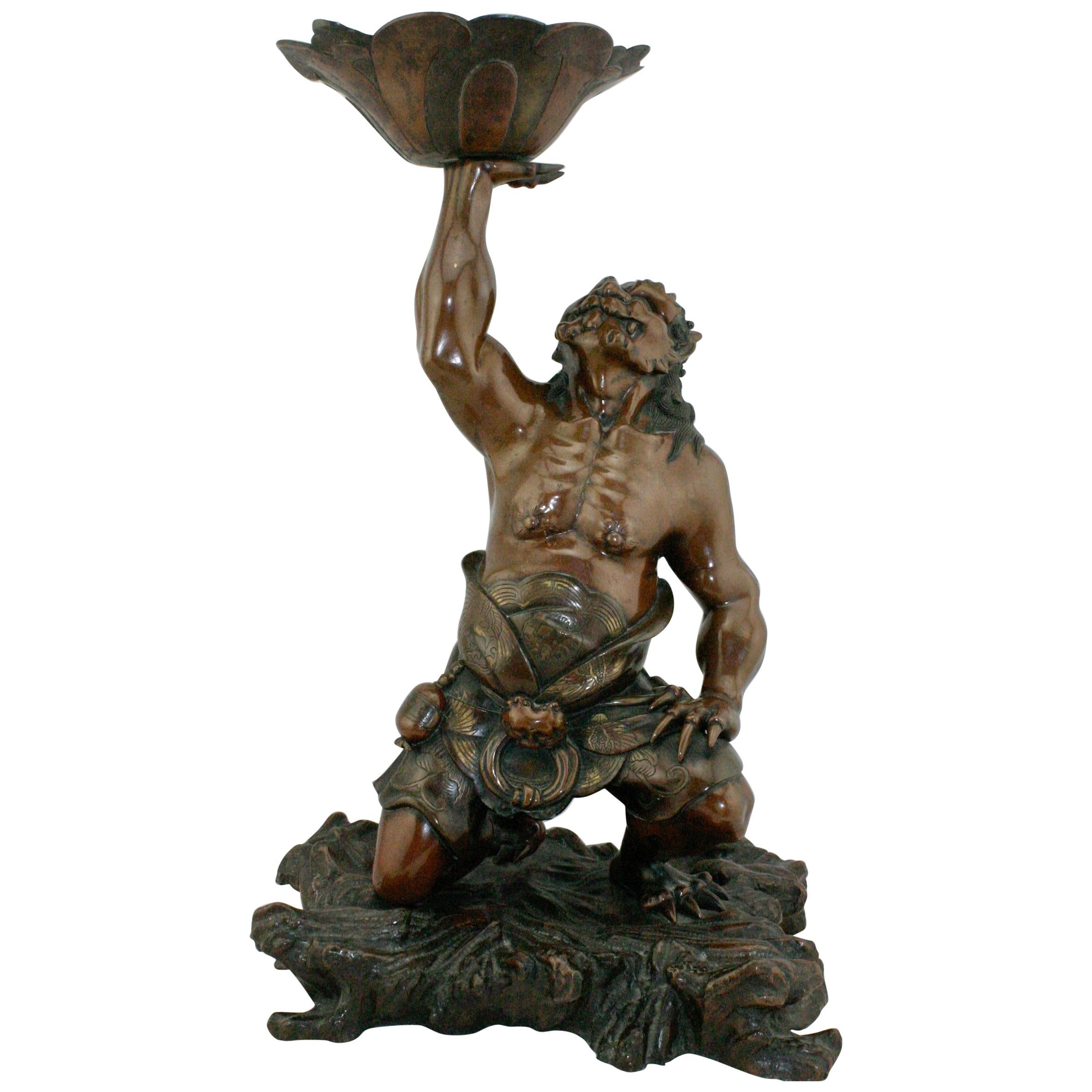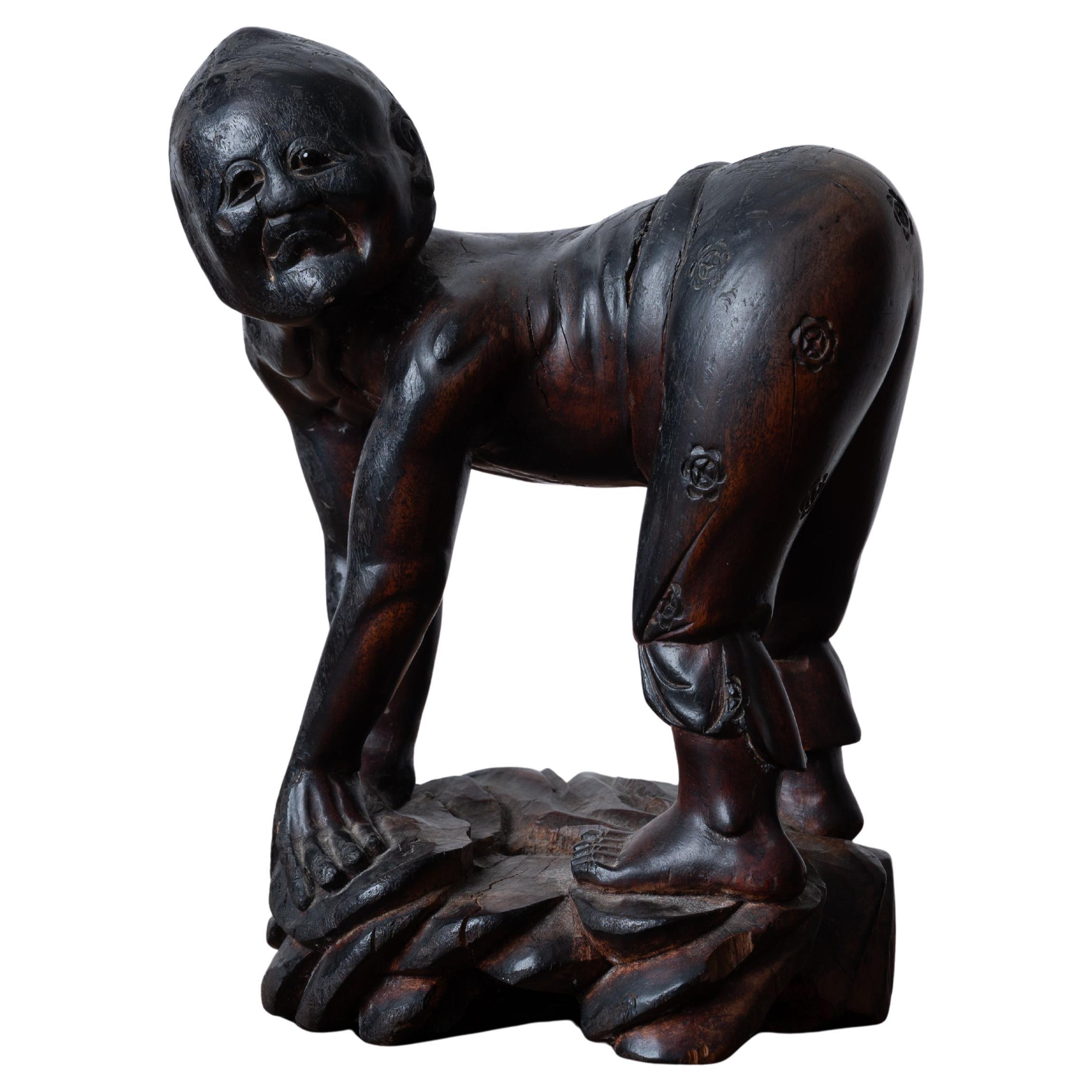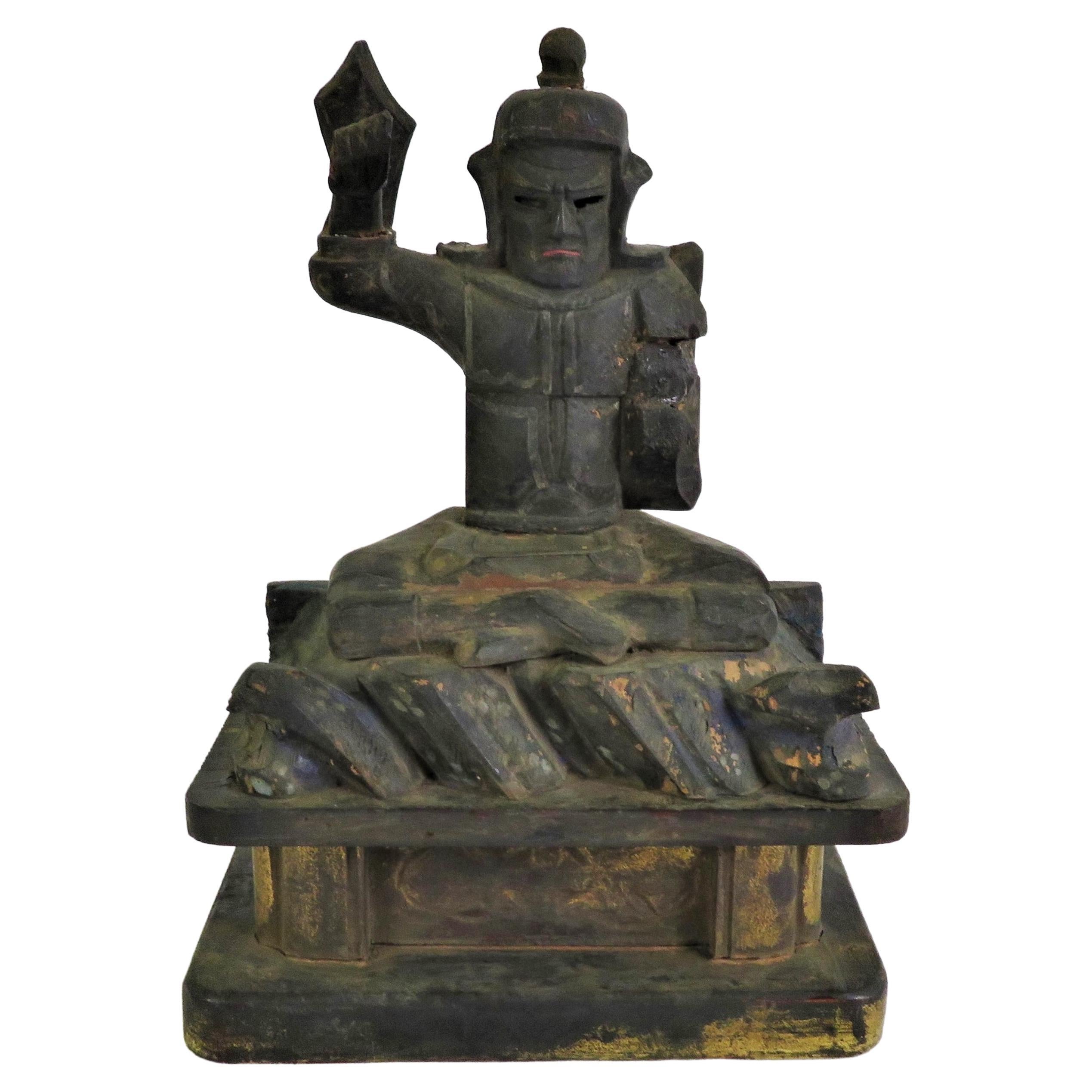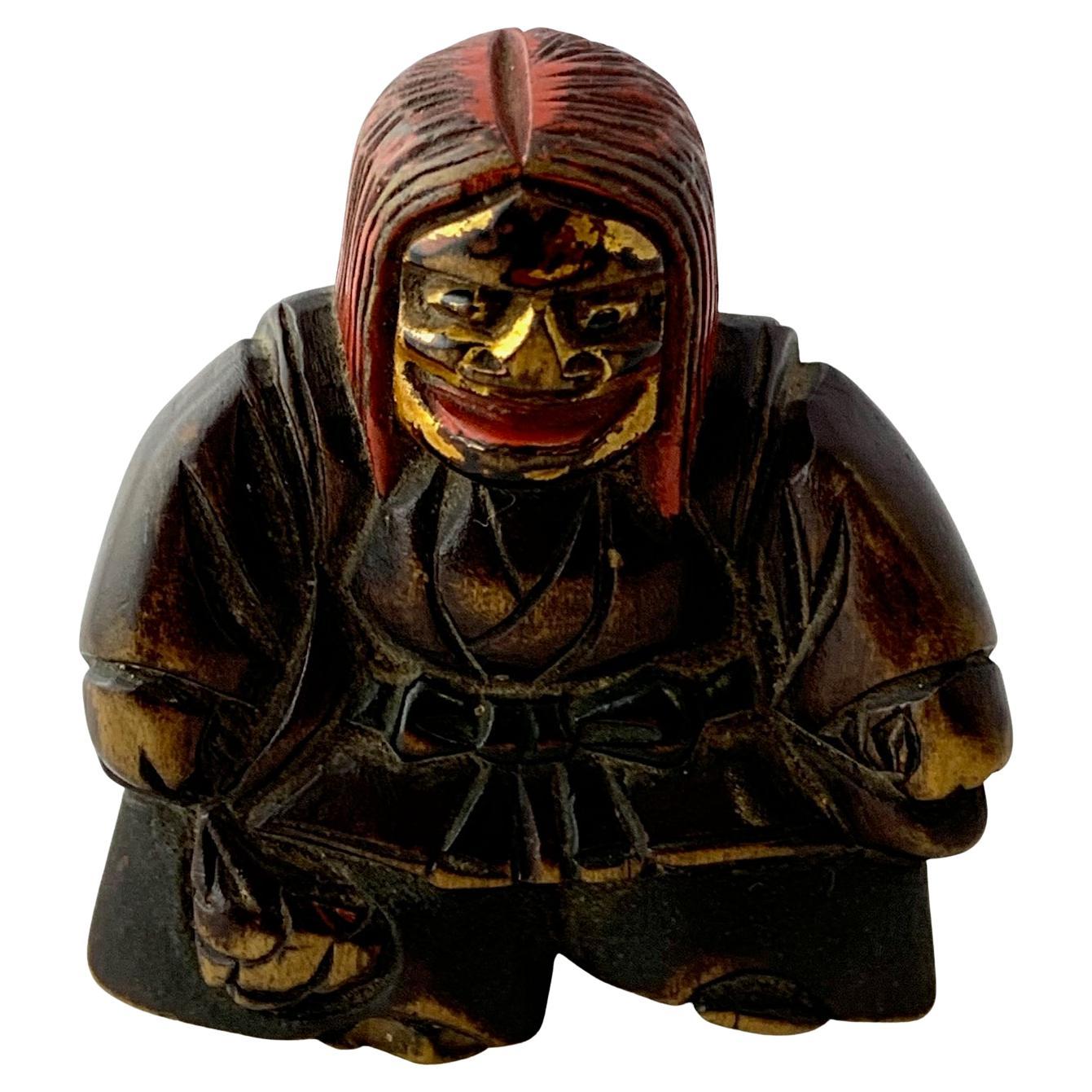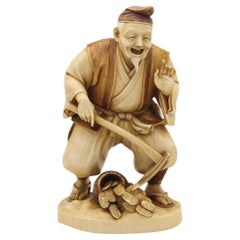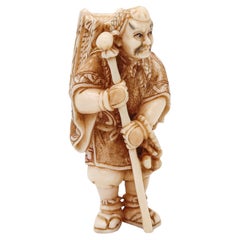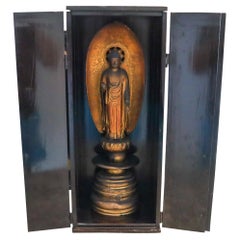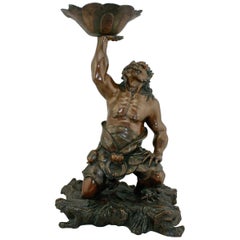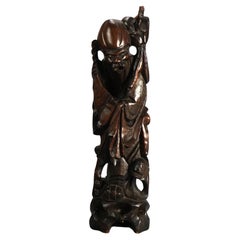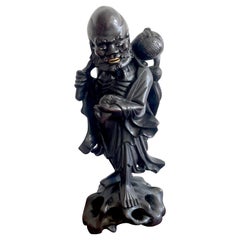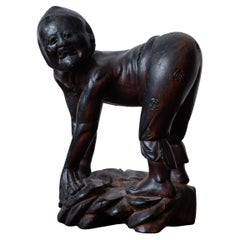Items Similar to JAPAN 1880 Meiji Signed Okimono Sculpture Of ONI Demon Holding Basket With Fish
Want more images or videos?
Request additional images or videos from the seller
1 of 7
JAPAN 1880 Meiji Signed Okimono Sculpture Of ONI Demon Holding Basket With Fish
$2,062.50
$2,75025% Off
£1,580.66
£2,107.5425% Off
€1,816.69
€2,422.2525% Off
CA$2,896.88
CA$3,862.5125% Off
A$3,242.15
A$4,322.8625% Off
CHF 1,697.15
CHF 2,262.8625% Off
MX$39,386.20
MX$52,514.9325% Off
NOK 21,549.46
NOK 28,732.6225% Off
SEK 20,335.60
SEK 27,114.1325% Off
DKK 13,555.68
DKK 18,074.2425% Off
About the Item
Meiji period okimono sculpture of Oni.
This is an exceptional okimono sculpture created in the late 19th century during the imperial Japan in the Meiji era period, back in 1880. The rare okimono sculpture has been carefully carved with fabulous details and accents in white nacre. The sculpture depicts the figure of ONI, standing in human-ish form with three clawed feet wearing shorts with a cloth tied around his shoulders and neck. He's holding a basket in the right hand and a large basket with a fish in the other. The Oni has well carved facial detail with raised horns and sharp pointed teeth along with inset eyes, claw like fingers, bracelets on either wrist, muscular arms and legs and a belly that sticks out. This piece is very well executed and retains all the original aged patina of over 100 years old. This piece was recently professionally cleaned and polished. This stupendous piece will be a great addition for your desk, your Japanese antiques collection, or your bijouterie cabinet.
Oni
In Japanese folklore, an Oni is a type of demonic creature, often depicted as a fearsome ogre or giant, with great strength and a terrifying appearance. They are generally considered to be of foreign origin, possibly introduced with Buddhism.
Okimono
This is a Japanese term meaning for display an ornament; art object; or decorative object, usually displayed in a tokonoma or butsudan "Buddhist altar". It is an ornament or figure, especially one placed in a guest room. An okimono may be a small Japanese carving, similar to but larger than a netsuke. Unlike the netsuke, which had a specific purpose, the okimono is exclusively decorative and was displayed in the tokonoma. During the Meiji period, many okimonos were made for export to the West.
Meiji period
This is an era of Japanese history that extended from October 23, 1868 to July 30, 1912.The Meiji era was the first half of the Empire of Japan, when the Japanese people moved from being an isolated feudal society at risk of colonization by Western powers to the new paradigm of a modern, industrialized nation state and emergent great power, influenced by Western scientific, technological, philosophical, political, legal, and aesthetic ideas. As a result of such wholesale adoption of radically different ideas, the changes to Japan were profound, and affected its social structure, internal politics, economy, military, and foreign relations. The period corresponded to the reign of Emperor Meiji. It was preceded by the Keiō era and was succeeded by the Taishō era, upon the accession of Emperor Taishō.
Year: Meiji, 1880.
Technique: Carved, engraved and accented with ochre ink.
Signature: Signed in the bottom in a red lacquer square cartouche with two Japanese characters.
Weight: 159.5 Grams, (0.16 Kg).
Measurements: 136 mm by 53 mm by 55 mm (5.35 x 2.1 x 2.15 Inches).
Disclosure Note: This is an antique relics piece, with over 100 years old or more and originally carved during the Meiji dynasty (1868-1912) in Japan.
Condition: The overall condition of this okimono is excellent. Beside the little normal wear, there is no damage and all parts are secured in their settings. This piece has been carefully inspected to guarantee the condition and authenticity.
INVENTORY REF: D070625VCEN/.7845
- Dimensions:Height: 5.35 in (13.59 cm)Width: 2.1 in (5.34 cm)Depth: 2.15 in (5.47 cm)
- Style:Meiji (Of the Period)
- Materials and Techniques:
- Place of Origin:
- Period:
- Date of Manufacture:1880
- Condition:Wear consistent with age and use. The overall condition of this okimono is excellent. Beside the little normal wear, there is no damage and all parts are secured in their settings. This piece has been carefully inspected to guarantee the condition and authenticity.
- Seller Location:Miami, FL
- Reference Number:Seller: D070625VCEN/.78451stDibs: LU8303245786222
About the Seller
5.0
Gold Seller
Premium sellers maintaining a 4.3+ rating and 24-hour response times
1stDibs seller since 2023
211 sales on 1stDibs
Typical response time: 4 hours
- ShippingRetrieving quote...Shipping from: Miami, FL
- Return Policy
Authenticity Guarantee
In the unlikely event there’s an issue with an item’s authenticity, contact us within 1 year for a full refund. DetailsMoney-Back Guarantee
If your item is not as described, is damaged in transit, or does not arrive, contact us within 7 days for a full refund. Details24-Hour Cancellation
You have a 24-hour grace period in which to reconsider your purchase, with no questions asked.Vetted Professional Sellers
Our world-class sellers must adhere to strict standards for service and quality, maintaining the integrity of our listings.Price-Match Guarantee
If you find that a seller listed the same item for a lower price elsewhere, we’ll match it.Trusted Global Delivery
Our best-in-class carrier network provides specialized shipping options worldwide, including custom delivery.More From This Seller
View AllJAPAN 1890 Meiji Carved Figure of Fortune God Daikoku As a Farmer With Coins
Located in Miami, FL
A Japanese carved sculpture of Daikoku.
Magnificent sculpture of the god of the fortune Daikoku WITH OVER 100 YEARS OLD, created in Japan during the Meiji period, circa 1890. The ca...
Category
Antique 1890s Japanese Meiji Sculptures and Carvings
Materials
Gold
$3,738 Sale Price
25% Off
JAPAN 1890 Meiji Sculptural Polychromate Netsuke Of a Yamabushi
Located in Miami, FL
Japanese Meiji period netsuke. of a Yamabushi.
This is an exceedingly beautiful and intricate carved netsuke, created during the imperial Japan in the Meiji period, back in he 1890....
Category
Antique 1890s Japanese Meiji Sculptures and Carvings
Materials
Bone
$1,048 Sale Price
25% Off
JAPAN 1810 Edo Period Large Butsudan Home Altar With Amida Nyorai In Wood
Located in Miami, FL
Large butsudan home altar with Amida Nyorai figure Edo Period (1600-1868)
This is a beautiful Japanese wooden statue of standing Amida Nyorai Buddha, from the Edo period (1600-1868)...
Category
Antique 1810s Japanese Edo Sculptures and Carvings
Materials
Gold, Brass
$3,738 Sale Price
25% Off
BLACK FOREST 1900 Germany-Swiss Carved Wood Nutcracker Old Gnome Figure
By Black Forest
Located in Miami, FL
A folk-art nutcracker carved in oak wood.
This is an elusive antique black forest nutcracker created in northern Europe, most probably in Germ...
Category
Antique Early 1900s German Black Forest Figurative Sculptures
Materials
Wood
$1,237 Sale Price
25% Off
JAPAN 1880 Meiji Highly Detailed Walking Cane With Monkeys In a Bamboo Forest
Located in Miami, FL
Waling cane from the Meiji Period (1868-1912).
This is a fabulous antique walking cane created in the imperial Japan during the Meiji period (1868-1912), circa 1880's. The cane was ...
Category
Antique 1880s Japanese Meiji Sculptures and Carvings
Materials
Wood
$3,637 Sale Price
25% Off
QING DYNASTY 20th Century Carved Tiger's Eye Foo-Dog Censer With Cover Lid
Located in Miami, FL
An early 20th century censer from the Qing Dynasty.
This is a beautiful highly detailed small censer, created in the early 20th century during the Qing Dynasty, circa 1910. The cens...
Category
Early 20th Century Chinese Qing Sculptures and Carvings
Materials
Multi-gemstone
$1,123 Sale Price / set
25% Off
You May Also Like
Japanese Meiji Gilt Bronze Figure of Oni Holding a Lotus Flower
Located in Sarasota, FL
Japanese Meiji period finely cast, patinated and partially gilded figure of Oni holding a lotus flower. Very fine and detailed decoration. No signature located. The figure is 17 1/2"...
Category
Antique Late 19th Century Japanese Other Metalwork
Materials
Bronze
Vintage Carved Wood Statue of the God Fukurokuju C1930
Located in Big Flats, NY
Vintage Asian Carved Wood Statue of the God Fukurokuju C1930
Measures - 19.25"h x 5"w x 4"d
Category
Early 20th Century Sculptures and Carvings
Materials
Wood
$360 Sale Price
20% Off
19th Chinese Carved Hardwood Figure of an Immortal Holding a Bat
Located in West Palm Beach, FL
This exquisite late 19th-century Chinese carved hardwood figure depicts an immortal holding a bat, symbolizing happiness and good fortune in Chinese culture. The workmanship is exemp...
Category
Antique Late 19th Century Chinese Chinese Export Sculptures and Carvings
Materials
Bone, Hardwood
$1,036 Sale Price
20% Off
A Japanese Carved Root Yōkai Figure, Meiji Period
Located in Savannah, GA
A japanese carved root yōkai figure, Meiji Period.
6 inches wide by 5 inches deep by 8 inches tall
Category
20th Century Japanese Figurative Sculptures
Materials
Wood
Late Meiji Period Folk Wood Carving Japanese God of War, Arts, Shrines Protector
Located in Miami, FL
Probably more than likely from a Japanese home altar, this is a folk art rendition of Hachiman Yahata no Kani, Japanese God of War, Archery, Culture and Pro...
Category
Antique Early 1900s Japanese Meiji Figurative Sculptures
Materials
Wood
$304 Sale Price
20% Off
Netsuke of an Oni, a Demon in Japanese Folklore, Wood, Early 20th Century
Located in Point Richmond, CA
A Meiji period netsuke depicting a formidable figure of an oni (demon) with a golden face and red hair. Onis were thought to ward off evil spirits and were often depicted on netsuke ...
Category
Early 20th Century Japanese Meiji Figurative Sculptures
Materials
Boxwood
More Ways To Browse
Pi Xiu
Indoor Fish Pond
Salvatore Riolo
Japanese Goban
Tsuda Eiju
Bato Kannon
Carved Mammoth Ivory
Samurai Horse Bell
Vintage Cast Iron Snail
Chinese Spinach Jade Horse
Design For Macha
Japanese Bronze Cow
Chinese Soapstone Bowl
Cerasuolo Coral Carving
Lakshmi Statue
Chinese Bound Foot Shoes
Samsara Artisanal
Burmese Chess Set
